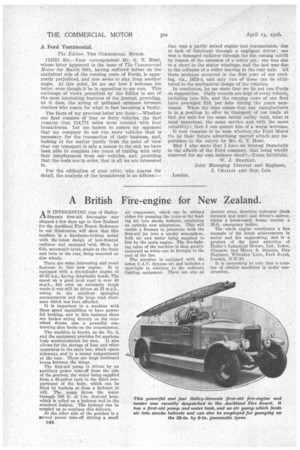A British Fire-engine for New Zealand.
Page 28

If you've noticed an error in this article please click here to report it so we can fix it.
A N INTERESTING type of Halley1-1_Simonis first-aid fire-engine *as shipped a few days ago to New Zealand for the Auckland Fire Board. Reference to our illustration will show that this machine is a handsome-looking model with the latest design of bow-fronted radiator and equipped 'with 36-in. by 6-in, pneumatic tyres, single at the front and twin at the rear, being mounted on disc wheels.
There are some interesting and novel features in this new engine. It is equipped with a six-cylinder engine of 40-55 h.p., having detachable heads. The speed on a good level road is over 40 m.p.h., but even on extremely rough roads it can still be driven at 15 m.p.h., owing to the excellent springing arrangements and the large road clearance which has been afforded.
It is important in a machine with these speed capabilities to have powerful braking, and in this instance there are brakes acting directly on the rearwheel drums also a powerful contracting shoe brake on the transmission.
The machine is known as the No. 2, and the equipment provides for spacious body accommodation for men. It also allows for the storage of hose and other apparatus in the main box, which opens sideways, and in a roomy compartment at the rear. There are large footboard boxes between the wings.
The first-aid pump is driven by an auxiliary power take-off from the side of the gearbox, the water being supplied from a .40-gallon tank in the third compartment of the body, which can be filled by buckets or from a hydrant at will. The pump drives the water through 180 ft. of 1-in, first-aid hose, which is coiled on a hydrant red in the standard fashion. The hydrant can be coupled up to continue this delivery.
At the other side of the gearbox is a second power take-off driving a small air compressor, which can be utilized either for pumping the tyres or for feeding air into smoke helmets, employing an entirely new adaptation. This will enable a fireman to penetrate with the first-aid .jet into a smoky atmosphere, both air and water being supplied to him by the main engine. The fire-fighting value of the machine is thus greatly increased as water can be brought to the root of the fire.
The machine is equipped with the latest C.A.V. dynamo set and includes a spot-light in addition to the ordinary lighting equipment. There are also an
electric siren, direction indicator (both forward and rear) and driver's mirror, whilst a brass-cased frame carries a 35-ft. emergency ladder.
The whole engine constitutes a fine example of the latest achievements in motor and fire engineering, and is a product of the joint activities of Halley's Industrial Motors, Ltd., Yoker, Glasgow, and Henry S. Simonis, 'Fire Engineer, Willesden Lane, Park Royal, London, N.W.10.
It is interesting to note that a number of similar machines is under construction.






























